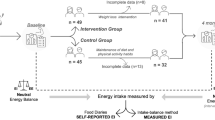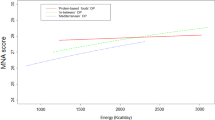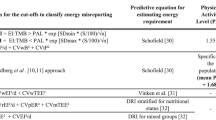Abstract
Objectives: The aim of the study was to validate a diet history interview (DHI) method and a 3-day activity registration (AR) with biological markers.
Subjects and study design: The reported dietary intake of 33 rheumatoid arthritis patients (17 patients on a Mediterranean-type diet and 16 patients on a control diet) participating in a dietary intervention study was assessed using the DHI method. The total energy expenditure (TEE), estimated by a 3-day AR, was used to validate the energy intake (EI). For nine subjects the activity registration was also validated by means of the doubly labelled water (DLW) method. The excretion of nitrogen, sodium and potassium in 24-h urine samples was used to validate the intake of protein, sodium and potassium.
Results: There was no significant difference between the EI and the TEE estimated by the activity registration or between the intake of protein, sodium and potassium and their respective biological markers. However, in general, the AR underestimated the TEE compared to the DLW method. No significant differences were found between the subjects in the Mediterranean diet group and the control diet group regarding the relationship between the reported intakes and the biological markers.
Conclusion: The DHI could capture the dietary intake fairly well, and the dietary assessment was not biased by the dietary intervention. The AR showed a bias towards underestimation when compared to the DLW method. This illustrates the importance of valid biological markers.
Sponsorship: The Faculty of Social Sciences, Umeå University; the Swedish Foundation for Health Care Sciences and Allergy Research; the Health Research Council in the Southeast of Sweden; the Swedish Rheumatism Association; the Swedish Nutrition Foundation; the JC Kempe Memorial Scholarship Fund; the ‘Borgerskapet i Umeå’ Fund, the ‘Uppsala Hemsysterskola’ Fund; Karlshamns AB; Nestlé Sweden AB; Van den Bergh Foods AB.
This is a preview of subscription content, access via your institution
Access options
Subscribe to this journal
Receive 12 print issues and online access
$259.00 per year
only $21.58 per issue
Buy this article
- Purchase on Springer Link
- Instant access to full article PDF
Prices may be subject to local taxes which are calculated during checkout

Similar content being viewed by others
References
Ainsworth BE, Haskell WL, Whitt MC, Irwin ML, Swartz AM, Strath SJ, O'Brien WL, Bassett DR, Schmitz KH, Emplaincourt PO, Jacobs DR & Leon AS (2000): Compendium of physical activities: an update of activity codes and MET intensities. Med. Sci. Sports. Exerc. 32 (Suppl. 9), S498–S504.
Bingham S & Cummings JH (1983): The use of 4-aminobenzoic acid as a marker to validate the completeness of 24 h urine collections in man. Clin. Sci. (Colch) 64, 629–635.
Bingham SA (1987): The dietary assessment of individuals; methods, accuracy, new techniques and recommendations. Nutr. Abstr. Rev. 57, 705–742.
Bingham SA (2002): Biomarkers in nutritional epidemiology. Public Health Nutr. 5, 821–827.
Bingham SA & Cummings JH (1985): Urine nitrogen as an independent validatory measure of dietary intake: a study of nitrogen balance in individuals consuming their normal diet. Am. J. Clin. Nutr. 42, 1276–1289.
Black AE (2000): Critical evaluation of energy intake using the Goldberg cut-off for energy intake:basal metabolic rate. A practical guide to its calculation, use and limitations. Int. J. Obes. Relat. Metab. Disord. 24, 1119–1130.
Black AE, Coward WA, Cole TJ & Prentice AM (1996): Human energy expenditure in affluent societies: an analysis of 574 doubly-labelled water measurements. Eur. J. Clin. Nutr. 50, 72–92.
Black AE, Goldberg GR, Jebb SA, Livingstone MB, Cole TJ & Prentice AM (1991): Critical evaluation of energy intake data using fundamental principles of energy physiology: 2. Evaluating the results of published surveys. Eur. J. Clin. Nutr. 45, 583–599.
Black AE, Prentice AM & Coward WA (1986): Use of food quotients to predict respiratory quotients for the doubly-labelled water method of measuring energy expenditure. Hum. Nutr. Clin. Nutr. 40, 381–391.
Bland JM & Altman DG (1986): Statistical methods for assessing agreement between two methods of clinical measurement. Lancet 1, 307–310.
Bouchard C, Tremblay A, Leblanc C, Lortie G, Savard R & Theriault G (1983): A method to assess energy expenditure in children and adults. Am. J. Clin. Nutr. 37, 461–467.
Department of Health (1991): Dietary Reference Values for Food Energy and Nutrients for the United Kingdom Report on Health and Social Subjects 41. London: HMSO.
Deurenberg P, Weststrate JA & Seidell JC (1991): Body mass index as a measure of body fatness: age- and sex-specific prediction formulas. Br. J. Nutr. 65, 105–114.
Håglin L, Hagman U & Nilsson M (1995): Evaluation of the meal model ‘Matmallen’ A means of estimating consumed amounts of food. Scand. J. Nutr. 39, 79–83.
Jakobsen J, Ovesen L, Fagt S & Pedersen AN (1997): Para-aminobenzoic acid used as a marker for completeness of 24 h urine: assessment of control limits for a specific HPLC method. Eur. J. Clin. Nutr. 51, 514–519.
Johansson G, Bingham S & Vahter M (1999): A method to compensate for incomplete 24-hour urine collections in nutritional epidemiology studies. Public Health Nutr. 2, 587–591.
Johansson G, Callmer E & Gustafsson JA (1992): Validity of repeated dietary measurements in a dietary intervention study. Eur. J. Clin. Nutr. 46, 717–728.
Lissner L, Lindroos AK & Sjöström L (1998): Swedish obese subjects (SOS): an obesity intervention study with a nutritional perspective. Eur. J. Clin. Nutr. 52, 316–322.
Livingstone MB & Black AE (2003): Markers of the validity of reported energy intake. J. Nutr. 133 (Suppl. 3), S895–S920.
Mangge H, Hermann J & Schauenstein K (1999): Diet and rheumatoid arthritis — a review. Scand. J. Rheumatol. 28, 201–209.
Rennie KL, Hughes J, Lang R & Jebb SA (2003): Nutritional management of rheumatoid arthritis: a review of the evidence. J. Hum. Nutr. Diet. 16, 97–109.
Roubenoff R, Roubenoff RA, Cannon JG, Kehayias JJ, Zhuang H, Dawson-Hughes B, Dinarello CA & Rosenberg IH (1994): Rheumatoid cachexia: cytokine-driven hypermetabolism accompanying reduced body cell mass in chronic inflammation. J. Clin. Invest. 93, 2379–2386.
Roubenoff R, Walsmith J, Lundgren N, Snydman L, Dolnikowski GJ & Roberts S (2002): Low physical activity reduces total energy expenditure in women with rheumatoid arthritis: implications for dietary intake recommendations. Am. J. Clin. Nutr. 76, 774–779.
Schoeller DA, Leitch CA & Brown C (1986): Doubly labeled water method: in vivo oxygen and hydrogen isotope fractionation. Am. J. Physiol. 251, R1137–R1143.
Schoeller DA (1988): Measurement of energy expenditure in free-living humans by using doubly labeled water. J. Nutr. 118, 1278–1289.
Schoeller DA (2002): Validation of habitual energy intake. Public Health Nutr. 5, 883–888.
Sköldstam L, Hagfors L & Johansson G (2003): An experimental study of a Mediterranean diet intervention for patients with rheumatoid arthritis. Ann. Rheum. Dis. 62, 208–214.
Speakman JR (1997): Doubly Labelled Water: Theory and Practice pp 110–111. London: Chapman & Hall.
Swedish National Food Administration (1999): Vikttabell. Uppsala: Swedish National Food Administration.
Westerterp KR & Goris AH (2002): Validity of the assessment of dietary intake: problems of misreporting. Curr. Opin. Clin. Nutr. Metab. Care 5, 489–493.
WHO (1985): Energy and Protein Requirements: Report of a Joint FAO/WHO/UNU Expert Consultation WHO Technical Report Series 724. Geneva: World Health Organization.
Acknowledgements
We express our gratitude to our collaborators, Lena Martinsson, Eva Wolke, Ingela Nilsson, Lena Henningsson, Marianne Olsson, Ann-Louise Karlsson, Mona Bäckström and Gunnel Gustavsson for administrative assistance, information, advice and support to the patients concerning their diet, help with the clinical examinations, and in the handling of blood and urine samples for chemical analysis.We thank Maria Bengtsson and Jenny Wannstedt for performing diet history interviews, Petra Rydén for her help with the processing of food questionnaires, and Anette Jonsäll and Christel Larsson for valuable discussions.We also express our gratitude to all the participants.
Author information
Authors and Affiliations
Corresponding author
Additional information
Guarantor: L Hagfors.
Contributors: LH participated in the conception, design, data analysis and the writing of the paper. KW participated in the data analysis and the critical revision of the paper. LS participated in the conception, design and the critical revision of the paper. GJ participated in the conception, design, data analysis and the critical revision of the paper.
Rights and permissions
About this article
Cite this article
Hagfors, L., Westerterp, K., Sköldstam, L. et al. Validity of reported energy expenditure and reported intake of energy, protein, sodium and potassium in rheumatoid arthritis patients in a dietary intervention study. Eur J Clin Nutr 59, 238–245 (2005). https://doi.org/10.1038/sj.ejcn.1602064
Received:
Revised:
Accepted:
Published:
Issue Date:
DOI: https://doi.org/10.1038/sj.ejcn.1602064
Keywords
This article is cited by
-
Low carbohydrate high fat-diet in real life assessed by diet history interviews
Nutrition Journal (2023)
-
Evaluation of dietary taste patterns as assessed by FFQ against 24-h recalls and biomarkers of exposure
European Journal of Clinical Nutrition (2019)
-
Total energy expenditure in adults aged 65 years and over measured using doubly-labelled water: international data availability and opportunities for data sharing
Nutrition Journal (2018)
-
Factors Predicting Sodium Intake of Korean Americans with Type 2 Diabetes
Journal of Immigrant and Minority Health (2018)
-
Intake of household salt in a Danish population
European Journal of Clinical Nutrition (2009)



